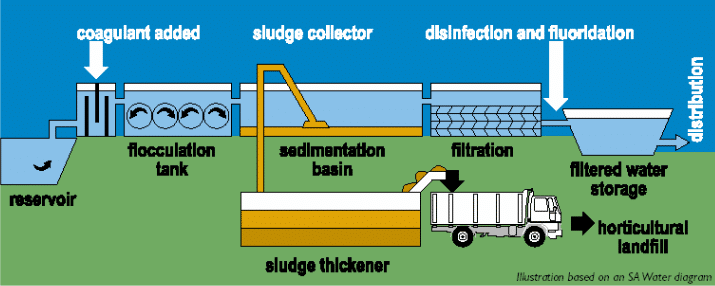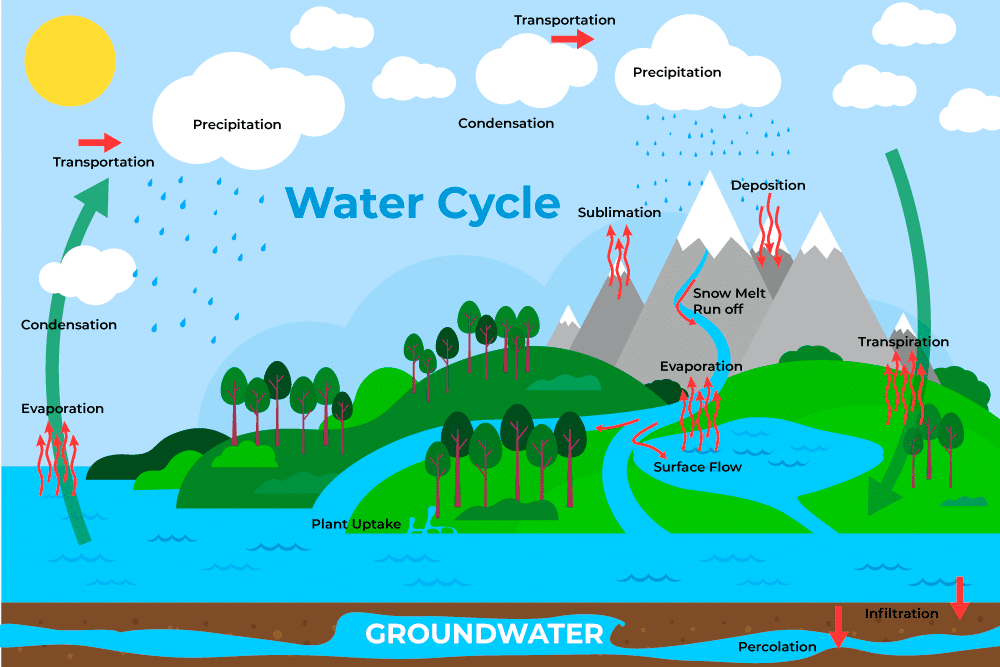Definition
A water purification plant is a facility designed to treat and purify water to make it safe for consumption or other purposes. It involves various processes to remove impurities, such as sedimentation, filtration, disinfection, and sometimes additional treatments like reverse osmosis or activated carbon filtration. The goal is to provide clean, safe, and potable water to the community or industries, Safe for human consumption, Pleasant to consumers. Provided at a reasonable cost.
Water Purification Plants have many processes and steps before a household turns on their tap and receives water. From the dam to the tap there is a vigorous process with many steps that are all essential in assuring high quality water for drinking. This activity looks at two of these processes; it will help you understand the processes of coagulation, flocculation and filtration which are all steps in water purification.
Coagulation and Flocculation
Coagulation and flocculation are processes used in water treatment to remove suspended particles and impurities. Coagulation involves the addition of chemicals to destabilize the particles and form larger aggregates. Flocculation then helps to bring these aggregates together to form larger, settleable particles. This allows for easier removal through processes like sedimentation or filtration. Overall, coagulation and flocculation are important steps in achieving cleaner and clearer water.
Filtration
Filtration is also another important element of the treatment process. This process involves the water passing through a bed of fine particles, usually sand. This process is called sand filtration. Other materials are also used in the filtration process. Generally they are layered. Originally filtration was a slow process, however because the sand filtration processes become less effective at removing fine suspended particles at higher water flow rates.
The water must be pretreated – coagulated and flocculated – before passing through the filter bed. Such high rate direct filtration processes are widely applied to raw water with low levels of suspended matter.

Coagulation and Flocculation Process
- Fill the plastic jug with 2L of tap water.
- Add the 1gram of soil to 2L of tap water.
- Using the large stirring paddle mix and stir it well into a homogenous solution for ~1min. This represents the soil that can be eroded and washed into
dams from catchment areas before the water is treated. - Using the 2L jug pour 500ml of the dirty solution into 4 separate containers, being careful you don’t spill the water. Make sure they’re as close to 500ml as possible.
- Place the four containers in order, next to each other as Control, 1ml, 2ml and 5ml.
- Leaving one of the 500ml containers as a control in this experiment, measure 1ml, 2ml, and 5ml with the mini plastic pipet from the Alum container supplied. Place the measured alum into the 25ml plastic beakers provided.
- Place the corresponding 25ml plastic beakers next to the corresponding 500ml beaker. Repeat this for each of the quantities of alum.
- Designate 1 person for each beaker to stir the mixtures and start each one at the same time.
- Start the timer, from the moment you add the Alum solution to all mixtures. Continue timing the entire activity.
- Add each alum solution (1ml, 2ml and 5ml) to the corresponding 500ml container and start to mix the solution with the paddles provided quickly for 1min. This is flash mixing so you need to do it fast and quickly (careful not to spill the dirty water). Make sure
you stir the control too. - After ~1min start to stir slowly (continue the timer) continue to stir the solution for another 5min intermediately.
- After a total of 6min stop stirring and remove the stirring wands. Let the solutions settle. Continue timing the activity.
- Complete the Part Two questions, remembering to check the timer to obtain your results.
- After 10min using the four corresponding 120ml plastic beakers, carefully pour the top layer of water from the 500ml plastic beakers into these, one by one, including the control water.
- Place a sheet of white paper in front of the plastic 500ml beakers, line up the 120ml beakers on the white paper. Compare and contrast the appearance of the 4 samples. Continue to answer the questions in Part Two.
- What do you observe? Does more alum take less time or more time to settle out? Is there an effect of increasing the alum? Is it economic to add more chemical?
- After completing the jar test using alum, think about the following questions.
What step in the Water Purification Process is coagulation and flocculation?
Coagulation and Flocculation is the 1 st steps in the WTP process. This is where coagulant is added (in this case, alum) and the mixture is stirred rapidly and then slowly. Then the particles settle out ready for the sedimentation process.
What do you think you will observe in the water when you test your process?
The particles are settled out and the water becomes clearer.
How do you think this process contributes to the overall water purification process?
It allows water to be cleaned more quickly as the larger particles are removed at the beginning of the process.
Filtration Process
- Place the plastic funnel on the stand and Using the plastic funnel, follow the steps to produce an individual filter for each group.
- Place another marked 120ml beaker under the funnel, ready to collect the filtered water.
- Place cotton wool at the bottom of the funnel and Place the washed gravel into the funnel above the cotton wool.
- Drain the water from the white sand and place the wet white sand above the gravel. (The sand needs to be wet so the water solution can be absorbed more easily. If it was not wet there is a possibility that the water would catch dry sand particles and pull them through into the clean water).
- Start to add the special coal on top of the sand layers (media layer).
- You have made your filter. filtered ~60ml. Make sure there is always about 30mm from the top so that the water doesn’t overflow.
- Place the original 120ml beaker next to the filtered 120ml sample respectively and compare the results.
- Discuss and comment on the clean water that has been produced by the filter. (Do not drink this water- it is not clean as the process is only to help you understand the WTP process.)
- The water is clean however it needs to progress through the rest of the processes to become safe to drink. After the filtration process the water needs to be disinfected and in some case fluoridised. It then goes into the distribution system where it gets stored in reservoirs ready for transport through pipes to your tap.
- Fill out the filtration activity sheet and Now its time to test the filter you have just constructed, using the laboratory filter provided.
- Now unscrew the top of the laboratory filter off and Using the tweezers, place a filter paper on the top of the plastic container.
- The pump draw the water through the filter into the container below then release the pump by releasing the plastic nob on the side then take the pump off.
- Screw off the top of the filter and remove the filter paper with the tweezers.
- Place the filter onto another piece of white paper and Repeat these steps with the filtered control water.
The Water Cycle Process
The movement of water above, on and below the earth’s surface has no beginning or end.
Surface Water:- Used to describe water on the earth’s surface- Lakes and Reservoirs, Rivers and Streams
Groundwater: All water that is beneath the earth’s surface. When we turn on the tap, start the washing machine or take a shower, we don’t necessarily think of the sun and the rain, but that is where the water comes from. The process known as the water cycle begins with energy from the sun reaching water in oceans, seas, rivers and lakes. Water evaporates and becomes water vapour.
As the water vapour rises, it cools and condenses into billions of droplets to form clouds. Vegetation is another source of water vapour. The roots of plants pump water out of the ground and pass it into the atmosphere in a process known as transpiration. Clouds hold rainwater as long as they stay warm. If the air cools, the droplets merge until they are so heavy that they fall back to Earth as rain, hail or snow. The atmosphere is capable of holding about 10 days’ supply of rain – enough to drop about 25 millimetres of freshwater over the entire surface of the planet.
Rain and snow falling within catchments can take several routes. Some evaporates, some seeps into the ground to become groundwater and some stays on or near the surface to form streams, and ultimately rivers. The water cycle is also referred to as the hydrological cycle. Both terms describe the solar-powered system that provides freshwater to the land- based ecosystems upon which we depend. The physical processes related to the movement and storage of water within the environment are seen in the diagram below:

HISTORY OF WATER PURIFICATION
The importance of good drinking water in maintaining human health was recognised early in history. However, it took centuries before people understood that their senses alone were not adequate judges of water quality. The earliest water treatments were based on filtering and driven by the desire to remove the taste and appearance of particles in water. Filtration was established as an effective means of removing particles from water and widely adopted in Europe during the eighteenth century.
As a result, drinking water purification systems were designed to reduce turbidity, thereby removing pathogens that were causing typhoid, dysentery and cholera. By the early twentieth century, better protection of water supplies from sewage pollution and simple but effective methods of water treatment (chlorination, sand filtration) had greatly reduced rates of waterborne disease in developed nations.
The water purification processes developed in the 19th century and refined during the 20th century are simple in nature. However, engineers have since developed ways of making these processes happen faster, in a smaller area and in a more controlled way at lower cost. As you will see in the coagulation and flocculation test (jar test), different amounts of alum in the process change the time the process takes to produce a result.
DIFFERENT TYPES OF PROCESSES
- Collection of water from the dam or reservoir
- Coagulant (Alum and Lime added)
- Flocculation Tank
- Sedimentation Basin or Tank
- Sludge Collection
- Sludge Thickening
- Storage of sludge, reuse and disposal
- Filtration
- Disinfection and Fluoridation
- Water Storage
- Water Distribution
You May Like: Social Pharmacy Assignment
COLLECTION OF WATER FROM DAMS
The water is collected from the dams and reservoirs via a pump to the Water Treatment Plant. The entire area from which a stream or river receives its water is called a catchment. A catchment is a natural drainage area, bounded by sloping ground, hills or mountains, from which water flows to a low point. Virtually everybody lives in a catchment, which may include hundreds of sub-catchments. What happens in each of the smaller catchments will affect the main catchment.
The water that comes out of a tap once flowed across a catchment and that is why catchments are a crucial part of urban water systems. The quality of the catchment determines the quality of the water harvested from it. Few communities have pristine water sources and the quality of water from most sources is at risk from activities occurring in the catchment.
Water resources can be classified assurface water or groundwater resources. In both cases the quality of the catchment determines the quality of the water harvested. Groundwater is a significant source of supply in many parts of rural Australia. It is also a significant ongoing source for several major urban centres. In parts of inland Australia, water from the Great Artesian Basin is used for urban, agricultural and mining purposes.
SEDIMENTATION BASINS AND TANKS
Some particles will spontaneously settle out from standing water (a process called sedimentation). Sedimentation is used to remove the majority of settleable solids from coagulated/flocculated raw water. The solids are removed before the water passes to the filter hence reducing the solids load on the filter and increasing the efficiency of the treatment plant.
SLUDGE COLLECTION AND THICKENING
Sludge produced in water treatment processes is both a waste product and a resource. Normally, the sludge is contaminated by heavy metals and sometimes by organic micro pollutants. This makes it necessary to treat the sludge before the valuable products can be recovered. The filter press is another process option available for dewatering sludge for final land disposal.
The sludge which gathers at the base of the mixing tanks is released into a valve and gravity fed through pipes to thickening tanks. At the thickening tanks the sludge is further processed and polyelectrolyte is added to help the settling process. The sludge is dewatered on a belt press and then squeezed into a dry cake are produced. The conveyer belt collects the dry cake and it is transported into a storage tank.
NOTE: Please write another subcategory in this pdf page no 15 to 23.
